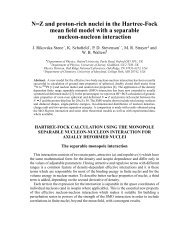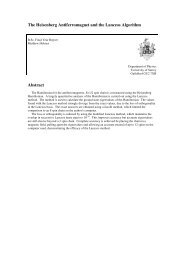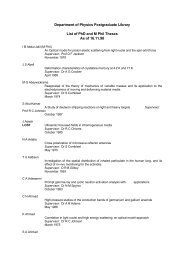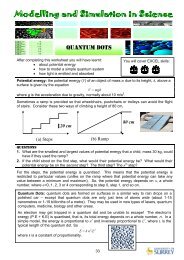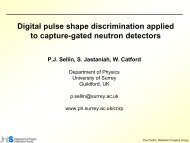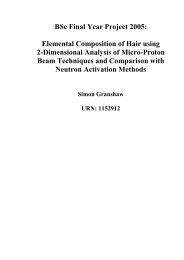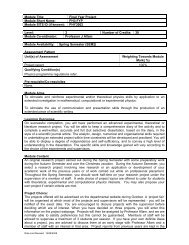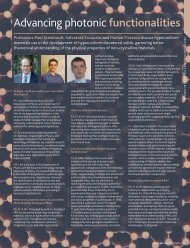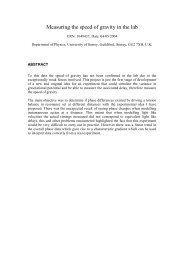Proceedings of the meeting - Department of Physics - University of ...
Proceedings of the meeting - Department of Physics - University of ...
Proceedings of the meeting - Department of Physics - University of ...
Create successful ePaper yourself
Turn your PDF publications into a flip-book with our unique Google optimized e-Paper software.
Slice pr<strong>of</strong>ile effects in variable flip angle HP 3 He MRIK. Teh, K.J. Lee, J.M. WildAcademic Radiology, <strong>University</strong> Of Sheffield, Sheffield, UKP29Introduction Unlike <strong>the</strong>rmally polarised NMR,hyperpolarised (HP) M o is non-recoverable and is progressivelydiminished after application <strong>of</strong> each RF pulse. Hence HP gasMRI is very sensitive to flip angle deviations and differentmethods have been implemented (1, 2) to maximise <strong>the</strong>utilisation <strong>of</strong> <strong>the</strong> non-constant M 0 . To minimise blurring throughk-space filtering (2) a constant transverse magnetisation can becreated using <strong>the</strong> variable flip angle scheme (1): θ(n)=tan -1 (1/√(N-n)) Eq.[1] where N is <strong>the</strong> total number <strong>of</strong> excitations, nis <strong>the</strong> nth excitation pulse and θ is <strong>the</strong> flip angle. In this work <strong>the</strong>performance <strong>of</strong> <strong>the</strong> variable flip angle scheme was investigated insingle slice and multi-slice 2-D spoiled gradient echo imagingexperiments with HP 3 He gas. The slice pr<strong>of</strong>ile in HP gas MRIhas previously been shown to be variable from RF view – RFview as a result <strong>of</strong> <strong>the</strong> non-ideal flip angle distribution causingdifferential rates <strong>of</strong> magnetisation depletion across <strong>the</strong> slice. Thiscan result in a “rabbit ear” pr<strong>of</strong>ile shape as described previously(2). A strategy to compensate for non-uniformity inmagnetisation response caused by this non-ideal view dependentslice pr<strong>of</strong>ile by using a variable slice select gradient betweenviews, is presented here.Methods Measurements were conducted on a 1.5Twhole body MRI system (Eclipse-Philips Medical System).Studies were performed using a mixture <strong>of</strong> (100ml 3 He and900ml N 2 ) contained in a 1 litre Tedlar plastic bag. The 3 He gas(Spectra Gases) was polarised on site to around 20% with opticalpumping rubidium spin exchange apparatus (GE Health). Aquadrature high quality factor (Q) T/R birdcage was used for allexperiments with homogeneous flip angle distribution, importantin experiments sensitive to flip angle changes. An interleavedsequence was used with N=4 pulses. Eq.[1] was used todetermine <strong>the</strong> <strong>the</strong>oretical amplitude <strong>of</strong> RF pulses needed per viewto maintain constant transverse magnetisation without any sliceselection scaling. Scaling for non-uniform slice pr<strong>of</strong>ile effects,introduced by <strong>the</strong> 2D slice selection process, was <strong>the</strong>nimplemented by determining <strong>the</strong> scale factor for RF pulseamplitude. To do this <strong>the</strong> transverse magnetisation, M xy (z) wassummed over a) <strong>the</strong> whole FOV, this represents <strong>the</strong> single 2-Dexperiment and b) by summing M xy (z) over <strong>the</strong> FWHM limitswhich represents <strong>the</strong> multi slice experiment - see Fig.[1]. Thelimits <strong>of</strong> ± FWHM/2 represent <strong>the</strong> scenario in multi-slicing dueto magnetisation burnout on ei<strong>the</strong>r sides <strong>of</strong> <strong>the</strong> excited slicethrough multi slicing. By taking limits <strong>of</strong> FWHM as shown inFig.[1] it was assumed that above and below <strong>the</strong> limits <strong>of</strong>FWHM <strong>the</strong> sum <strong>of</strong> <strong>the</strong> magnetisation is zero. Diffusion effectsbetween slices are negligible in <strong>the</strong>se low N experiments due to<strong>the</strong> short TR. The sequence was run with 256 samples, 13 mmslice thickness and a TR <strong>of</strong> 80ms.-FOV/2-FWHM/2FWHM/2FWHMFig.[1]- limits <strong>of</strong> integration <strong>of</strong> M xy (z) for scenarios a) and b).Results Fig.[2a] shows <strong>the</strong> plot <strong>of</strong> normalised magnetisationversus pulse number, n, as calculated by summing M xy (z) overFOV limits for <strong>the</strong> <strong>the</strong>oretical flip angles (30°,35°,45°,90°) asgiven by Eq.[1]. It is obvious that a non-steady magnetisationresponse is found despite using <strong>the</strong> variable flip angle scheme –ZFOV/2we attribute this to view dependent slice pr<strong>of</strong>ile effects (2).Fig.[2b] has <strong>the</strong> same magnetisation response plotted over <strong>the</strong>FWHM limits <strong>of</strong> integration. The plot enables determination <strong>of</strong><strong>the</strong> slice selection scaling to achieve constant M o . From this data<strong>the</strong> slice thickness was scaled per view as illustrated in Fig.[3a]where <strong>the</strong> slice pr<strong>of</strong>ile changes with n. Notice changes in <strong>the</strong>measured slice pr<strong>of</strong>ile width due to slice selection scaling.Fig.[3b] is <strong>the</strong> corresponding curve depicting magnetisationchanges as a function <strong>of</strong> n with an integration limit <strong>of</strong> <strong>the</strong> wholeFOV. Despite <strong>the</strong> variable flip angle and slice select scaling anon-steady magnetisation response is still seen. Fig.[4a] showsplot <strong>of</strong> slice pr<strong>of</strong>ile, M xy (z), over <strong>the</strong> limits <strong>of</strong> <strong>the</strong> FWHM andFig.[4b] shows corresponding normalised magnetisationresponse from integrating between <strong>the</strong>se limits –note <strong>the</strong> almostflat response in this case.Normalised MoMoMo1.41.351.31.251.21.151.11.05FOV / 2∑−FOV/ 2M xy( z)11 2 3 4n pulsesFig.[2a]2.5 x 105 21.5-6.5mm10.50-FOV/2ZFig.[3a]14 x 104121086420-∆Z/2ZFig[4a]6.5mmFOV/2∆Z/2Normalised MoNormalised MoNormalised Mo1.21.181.161.141.121.11.081.061.041.020.980.960.940.920.90.8811 2 3 4n pulses1Fig.[2b]0.861 2 3 4n pulses1.041.0210.980.960.940.920.90.88FWHM / 2FWHM / 2Fig.[3b]0.861 2 3 4n pulsesFig[4b]Conclusion In this work it was demonstrated that variableflip angle techniques previously used in 2D HP gas MRI areprone to error and can provide a non-ideal non-constant magnetisationresponse caused by <strong>the</strong> non-uniform distribution <strong>of</strong> flipangles across <strong>the</strong> slice (2). By implementing a variable slice selectgradient in conjunction with variable flip angle techniquesenables us to maintain constant M o throughout <strong>the</strong> multi-pulseexperiment. The results presented here are directly applicable to<strong>the</strong> high acceleration factor parallel imaging techniques that canbe achieved with HP gas using low numbers <strong>of</strong> RF excitations(3). Future experiments will include implementation in 2D imagingsequences with more pulses (higher N), and also <strong>the</strong> possibility<strong>of</strong> tailoring <strong>the</strong> slice pr<strong>of</strong>ile <strong>of</strong> each pulse in <strong>the</strong> sequence.References[1] Zhao L et al ,J Magn Reson Ser B 1996;113:179-183[2] Wild JM et al, Magn Reson Med 2002;47:687-695[3] Lee R et al Magn Reson Med 2006;55:1132-1141.Acknowledgement EPSRC #GR/S81834/01(P), GE Health,Spectra Gases, Aerosol Society UK∑−FWHM/ 2FOV / 2∑−FOV/ 2∑−FWHM/ 2M xy( z)M xy( z)M xy( z)



